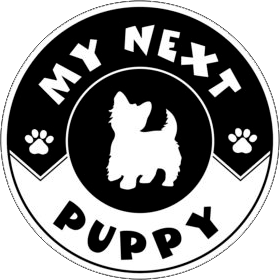-
Goldendoodle
In the 1990s, breeders in both North America and Australia began crossing golden retrievers with standard poodles, thus the Goldendoodle was born. The original purpose of the cross was to attempt to develop guide dogs suitable for visually impaired individuals with allergies. However, their popularity did not end there! Since 2005, Goldendoodles have been moderately used as guide dogs, therapy dogs, diabetic dogs, search dogs, and rescue dogs, as they have inherited the poodle's intelligence and the golden retriever's ease of training. Goldendoodles have also become increasingly used as domestic pets due to their affection towards families, friendliness, and patience with kids and strangers.
There are three main coat types. There is the straight coat, which is flat and resembles more of a golden retriever coat. The wavy coat type is a mixture of a poodle's curls and a golden retriever's straighter coat. The last coat type is curly, which tends to look more like the poodle coat. A Goldendoodle's size is generally somewhere between that of its poodle parent and golden retriever parent.
There are a few different ways breeders are producing Goldendoodles.
F1 = 50% Golden Retriever and 50% Poodle – This is Golden to Poodle cross, this is the first generation, resulting in healthier offspring. Hair type can be smooth like a Golden, or wavy/shaggy or occasionally a Wirey looks like an Irish wolfhound (but with a softer feel), they can shed or not shed, pups in the same litter can vary.
F1-B = 25% Golden Retriever and 75% Poodle (F1 Goldendoodle and Poodle cross) – This is Goldendoodle bred back to Poodle.
F2 = F1 Goldendoodle and F1 Goldendoodle cross – this combination you get the same percentage of Golden Poodle mix as you would an F1 Goldendoodle.
F3 = F2 Goldendoodle and F2 Goldendoodle cross
Multi-generation = F3 or higher generation Goldendoodle and F3 or higher generation Goldendoodle cross
-
Shih Tzu
A compact and solid dog, the Shih Tzu's long, flowing double coat is its most distinctive feature. The word Shih Tzu means “lion” and although this dog is sweet and playful, he is not afraid to stand up for himself! One of the most popular dogs in the United States according to AKC Registration Statistics, this portable pooch has a distinctively arrogant carriage with his head well up and tail curved over the back.
History
Cherished by Chinese royals as prized house pets for over a thousand years, it is believed to have descended from crossing the Lhasa Apso or Tibetan mountain dog and Pekingese. The Shih Tzu was the house pet for most of the Ming Dynasty and was discovered by soldiers in England during World War II.
Temperament
As the sole purpose of the Shih Tzu is a companion and house pet, he should be lively, alert, friendly, and trusting towards all. He requires minimal exercise, but his long, luxurious coat needs daily brushing and maintenance.
- Toy Group; AKC recognized in 1969.
- Ranging in size from 8 to 11 inches tall at the shoulder and 9 to 16 pounds.
- Companion, house pet.
Environment
- Apartment is fine.
- Fairly active indoors.
Exercise
- Daily light exercise.
Grooming
- Daily brushing.
- Periodic professional grooming recommended.
- Little to no shedding.
- Easy on allergy sufferers.
-
Norwegian Elkhound
A solid, sturdy hunter of elk, bear, and other wild animals, the Norwegian Elkhound has a temperament that is dignified, independent and generally, friendly. A hardy silver-grey dog with distinctive saddle markings and medium in size and substance, the Norwegian Elkhound is not only known for its hunting ability but also for its versatility and stamina, which in rugged terrains remains unparalleled.
History
The Norwegian Elkhound comes down to us through more than six millennia with all his Nordic traits untainted. An ancient breed from Scandinavia, the Elkhound worked as a hunting and guard dog for the Vikings. The dogs tracked, encircled, and held game such as bear and moose for the hunter. The breed was not shown until 1877 when the Norwegian Hunters' Association held its first show.
Temperament
The Norwegian Elkhound is bold and energetic, an effective guardian yet normally friendly, and does well with children, especially when introduced to them at a young age. The Elkhound is a very people-oriented breed and does not like to be shut away from its family. The breed does require regular exercise but does not require elaborate grooming procedures.
- Hound Group; AKC recognized in 1913.
- Ideal size ranged from 19 to 20 inches tall at the shoulder and 48 to 55 pounds.
- Elk hunter.
Environment
- Apartment is ok.
- Fairly active indoors.
- Thrive in cooler climates.
Exercise
- Daily vigorous exercise.
Grooming
- Daily brushing.
- Heavy seasonal shedding.
-
Havanese
The National Dog of Cuba and the country's only native breed, the Havanese is a small, sturdy dog with a friendly disposition. His wavy, silky coat is profuse, but remains extremely light, insulating and protecting the breed against harsh tropical heat. His coat, which comes in all colors, should remain untrimmed. The Havanese's popularity in the show ring has grown quickly, and they are also now high in demand as a family pet. The Havanese does really well with children and other pets.
History
An old breed, the Havanese is a descendent of breeds brought to Cuba from Spain and could also be related to the Tenerife, an ancestor of the entire Bichon family. Once known as the Havana Silk Dog and the Spanish Silk Poodle, the Havanese evolved from its role as a pampered lap-dog of the aristocracy into a family companion responsible for being a watchdog, child's playmate, and herder of the family's poultry flock.
Temperament
The Havanese is trainable and intelligent and possesses a naturally affectionate temperament, which making the breed an ideal family pet. Although a toy dog, they remain energetic and require some form of daily exercise. The breed's non-shedding coat makes it suitable for allergy sufferers, but regular grooming is necessary to keep the coat in top condition.
- Toy Group; AKC recognized in 1996.
- Ranging in size from 8 to 11 inches tall at the shoulder.
Environment
- Apartment is fine.
- Very active indoors.
Exercise
- Light to moderate daily exercise.
Grooming
- Regular professional grooming recommended.
- Little to no shedding.
- Easy on allergy sufferers.
-
Golden Retriever
The Golden Retriever, with its intelligence and eager to please attitude, is one of the most popular breeds in the United States according to AKC registration statistics. The working ability that has made the Golden Retriever such a useful hunting companion also make him an ideal guide, assistance, and search and rescue dog. The golden-colored coat is the hallmark of this versatile breed and can range from light to dark gold.
History
The Golden Retriever originated in the Scottish Highlands in the late 1800s and was used predominantly for hunting. He crossed his original “Yellow Retriever” with the Tweed Water Spaniel (now extinct) found on his estate. Later integrations of Irish Setter, Bloodhound, and more Tweed Water Spaniel produced the retriever we know today.
Temperament
This active and energetic Sporting breed can adapt to many different living situations but requires daily exercise. His water-repellant double-coat sheds seasonally and needs regular brushing. With his friendly temperament and striking golden color, this breed is both beautiful to look at and a joy to own. The Golden Retriever is great with children and other pets. They have an average lifespan of 10-12 years.
- Sporting Group; AKC recognized in 1925.
- Average size: from 55 to 75 pounds.
- Devoted companions, hunting dog.
Environment
- Apartment is ok.
- Moderate activity indoors.
Exercise
- Daily moderate exercise.
- Love interaction and games.
Grooming
- Easy care.
- Regular brushing.
- Average shedding.
-
Lhasa Apso
The Lhasa Apso is a small, hardy breed with a beautiful cloak of hair that parts down their back from head to tail. Their temperament is unique: joyful and mischievous, dignified, and aloof. An independent breed, the Lhasa's goal in life is not necessarily to please their master. Popular in the show ring, the breed also excels at activities that provide constant challenges, such as agility.
History
The Lhasa Apso originated hundreds of years ago in the isolated reaches of the Himalayan Mountains. It functioned primarily as a household sentinel, guarding homes of Tibetan nobility and Buddhist monasteries, particularly in or near the sacred city of Lhasa. In 1933, C. Suydam Cutting introduced the first Lhasas to the U.S. gifts from the 13th Dalai Lama.
Temperament
Bred as indoor watchdogs for hundreds of years, Lhasas can be suspicious of strangers, so early socialization is critical. They thrive living with adults or families with older children and enjoy regular walks. A long-coated breed, they also require frequent grooming. Many pet owners enjoy keeping their Lhasa in the shorter “puppy cut.”
- Non-Sporting Group; AKC recognized in 1935.
- Ranging in size from 10 to 11 inches tall at the shoulder and 12 to 18 pounds.
- Companion; watchdog.
Environment
- Apartment is fine.
- Active indoors.
Exercise
- Daily light exercise.
Grooming
- Regular brushing.
- Regular professional grooming.
- Very little shedding.
-
Labradoodle
The Labradoodle is a hybrid breed of dog derived from breeding a Labrador Retriever and a poodle. At their best, Labradoodles are intelligent, friendly, and affectionate. They come in three sizes: miniature (weighing 15 to 30 pounds), medium (30 to 45 pounds), and standard (45 to more than 100 pounds). Because they are a crossbreed their traits are not fixed, so there is no guarantee that the Labradoodle puppy you purchase will fall into the desired weight range.
Labradoodles have a moderate activity level. Larger Labradoodles may be more active than their smaller kin. They need a good walk or active playtime each day, and, if you're interested (and the dog's overall health is good enough), they are athletic enough to participate in such dog sports as agility, flyball, obedience, and rally. They can also be excellent therapy dogs.
Both of the breeds used to create Labradoodles tend to be smart and learn quickly. If you begin socialization and training early and use positive reinforcement techniques such as praise, play, and food rewards, you will be rewarded with a wonderful companion. Their large size gives them the sturdiness to withstand roughhousing with little children. Their endearing temperament makes them the perfect addition to any family. They are also a very hearty dog, being a hybrid. They can live for 10-12 years on average.
Poodles have a reputation for being hypoallergenic, meaning that they can be tolerated by people who have allergies to dogs. Because they have the Poodle in their heritage, Labradoodles are sometimes promoted as being hypoallergenic. But allergies are not caused by a particular dog coat type but by dander. Some people with mild allergies react less severely to particular dogs like the Labradoodle.
-
Shiba Inu
The smallest of the Japanese native breeds, the Shiba Inu was originally developed for hunting in the dense undergrowth of Japan's mountainous areas. Alert and agile with keen senses, he is also an excellent watchdog and companion. His frame is compact with well-developed muscles and he possesses a double coat that can be black and tan, red, or red sesame.
History
Descended from the primitive dogs of the ancient people of Japan, the Shiba Inu was bred to hunt small wild game, boar and bear. The name Shiba in Japanese means brushwood, after the breed's hunting terrain or the color of brushwood leaves in the fall, and Inu means dog. World War II nearly spelled disaster for the Shiba due to bombing raids and distemper, but after the war, bloodlines were combined to produce the breed as it is known today.
Temperament
The Shiba has an independent nature and can be reserved toward strangers but is loyal and affectionate to those who earn his respect. The Shiba adapts well to different living situations but must be exercised regularly on a leash or in a secure area. Early obedience training and regular brushing are musts.
- Non-Sporting Group; AKC recognized in 1992.
- Ranging in size from 13 to 16 inches tall at the shoulder and 17 to 23 pounds.
- Bird/Small game hunter.
Environment
- Apartment is ok.
- Moderate activity indoor.
Exercise
- Daily light exercise.
Grooming
- Easy care.
- Heavy seasonal shedding.
-
Cockalier
The Cockalier is a cross between the Cavalier King Charles Spaniel and the Cocker Spaniel. The best way to determine the temperament of a mixed breed is to look up all breeds in the cross and know you can get any combination of any of the characteristics found in either breed. Not all of these designer hybrid dogs being bred are 50% purebred to 50% purebred. It is very common for breeders to breed multi-generation crosses.
-
Coton De Tulear
Coton De Tulear is the French word for Cotton. Like the name suggests the most conspicuous feature of the Coton De Tulear is its coat, which is cottony or fluffy rather than silky. It has a long topcoat. The fluffy hair covers the thin, lightly-muscled forelegs. Colors come in white ” black and white and tri-colored. (White is preferred by show breeders.) Some have slightly yellowish markings on the ears.
Temperament
This is a typical bichon-type dog. Very friendly, gentle, affectionate, and alert. Cotons are very sociable dogs that get along well with children, other dogs, and animals. Very attached to its home and master – wanting always to be in their presence and trying its best to please. The Coton makes a great watchdog. Full of tricks and surprises to fulfill his master's every wish. One of their most endearing traits is a tendency to jump and walk on their hind legs. Their teasing expressions enhance any home willing to spend a few moments a day in the necessary play and grooming routines. The Coton learns quite quickly but can be a little bit stubborn without the proper leadership. They are intelligent and eager to work. Make sure you are this dog's firm, confident, consistent pack leader to avoid Small Dog Syndrome, human-induced behavior problems. Always remember, dogs are canines, not humans. Be sure to meet their natural instincts as animals.
- Height, Weight
- Height: 10-12 inches (25-30 cm.)
- Weight: 12-15 pounds (5.5-7 kg.)
Environment
- Apartment is fine.
- Fairly active indoors.
Exercise
- Daily moderate exercise.
- Love agility.
Grooming
- Daily brushing.
- Professional grooming recommended.
- Little to no shedding.
- Easy on allergy sufferers.

 Available Puppies
Available Puppies What People Are Saying
What People Are Saying